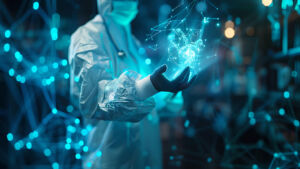Arizona State University’s School of Earth and Space Exploration led a media day to show the public their groundbreaking research in a variety of different fields.
I saw how they plan to transform science education using virtual reality and augmented reality, a lab that is attempting to learn how to forecast volcanic eruptions and scientists creating a spacecraft to find water on the moon.
Ariel Anbar is a president’s professor at the School of Earth and Space Exploration and the School of Molecular Sciences. He is also the director of Center for Education Through eXploration.
“We’re all about bringing the principles of what we call active learning into online education,” Anbar said. “Most of you when you think about the online learning experience you probably think of watching a video and PowerPoint slides. All of which is true. It’s part of online learning. But what we are doing here at ASU is raising the bar on what it’s all about.”

They are raising the bar by bringing virtual reality and augmented reality into the classrooms of middle schools and high schools. I tried out augmented reality first. They explained how most students memorize the phases of the moon, but they don’t necessarily understand them. So, when I held the smartphone, it first looked like a normal camera setting; however, then the moon, the sun and Earth popped up right on the table when looking through the smartphone. When I changed position around the table, I could see what the sun, the moon and Earth looked like from different angles.
For virtual reality, you put on a headset and all of a sudden, you’re in space looking at the solar winds that surround the sun. The only thing that grounds you is the wand you hold in your hand to direct you to where you need to go.
“We want to get the best science learning technology in the hands of kids,” Anbar said. “And we want to help teachers teach. We spend lots of money sending people to space and doing other space-related stuff. We learn amazing things from that. Kids get excited by that. But, actually connecting those amazing things that we’re doing with science to what these teachers need to teach is a big bridge. We’re providing that connection, and we’re doing it around these really cool immersive technologies.”
Next, we headed outside in between the building and a parking garage to learn about volcanos and magma. Christy Till led this demonstration. She is an assistant professor at the School of Earth and Space Exploration and an Earth and planetary scientist with a focus on volcanos and their magmatic processes.
“We’re interested in the processes that form magma underneath volcanoes and then what causes them to erupt and how long we have until that happens underground until the actual eruption,” Till said. “This is really important in helping better forecast volcanic eruptions and better protecting the public and all the infrastructure around volcanic eruptions.”
She also said the United States has over 150 active volcanoes, and the entire world has over 1,500. “There’s almost a billion people who live in the threat of volcanic eruptions,” Till said.
She stood in front of a grey garbage can that was filled with water, ping pong balls and tennis balls. “What we’re going to show you is a simulation of one of the ways we think volcanic eruptions are caused, which is the buildup of gas in the magma chamber underneath. We have a trash can simulating our magma chamber underneath the ground, and we’re going to put some gas in it, and it’s going to build up pressure, and it’s going to create an explosion.”
Those ping pong balls and tennis balls represented the rocks that get thrown out in volcanic eruptions. We all put safety goggles on and backed up about 20 feet. One of the students put the gas in the trash can and backed away. Ten to 15 seconds later, there’s a large boom, and the trash can and all its contents fly up into the air. A car alarm from the parking garage went off in response. After the demonstration, we went to the EPIC lab where they do the actual research about magma.
Next, we went to learn about the school’s LunaH-Map CubeSat mission to be launched in 2020. The spacecraft is the size of two shoe boxes and will create the highest resolution map ever created for the south pole of the moon. They will be searching for traces of water and hydrogen.
“It has all the components you would find in a big spacecraft just miniaturized,” said Craig Hardgrove, an assistant professor at the school and also the principal investigator for the mission.
“We want to know where this water is to use as a resource, so when we send future landers and future human explorers to the moon, water can be used as a fuel, and it can also be used to drink, so we want to use that to our benefit,” Hardgrove said.
I was able to walk around and see all the different parts they were working on. I did so with a hairnet, a full-length lab suit and blue slippers over my boots. It was difficult to imagine everything they were working on to fit in a contraption the size of two shoe boxes, yet they had done a 3D printed version, and they assured us that everything fit.
I thoroughly enjoyed taking part in this day and learning about the various different projects that the university is pursuing. I hope to see even more innovative and fascinating projects in the near future.



